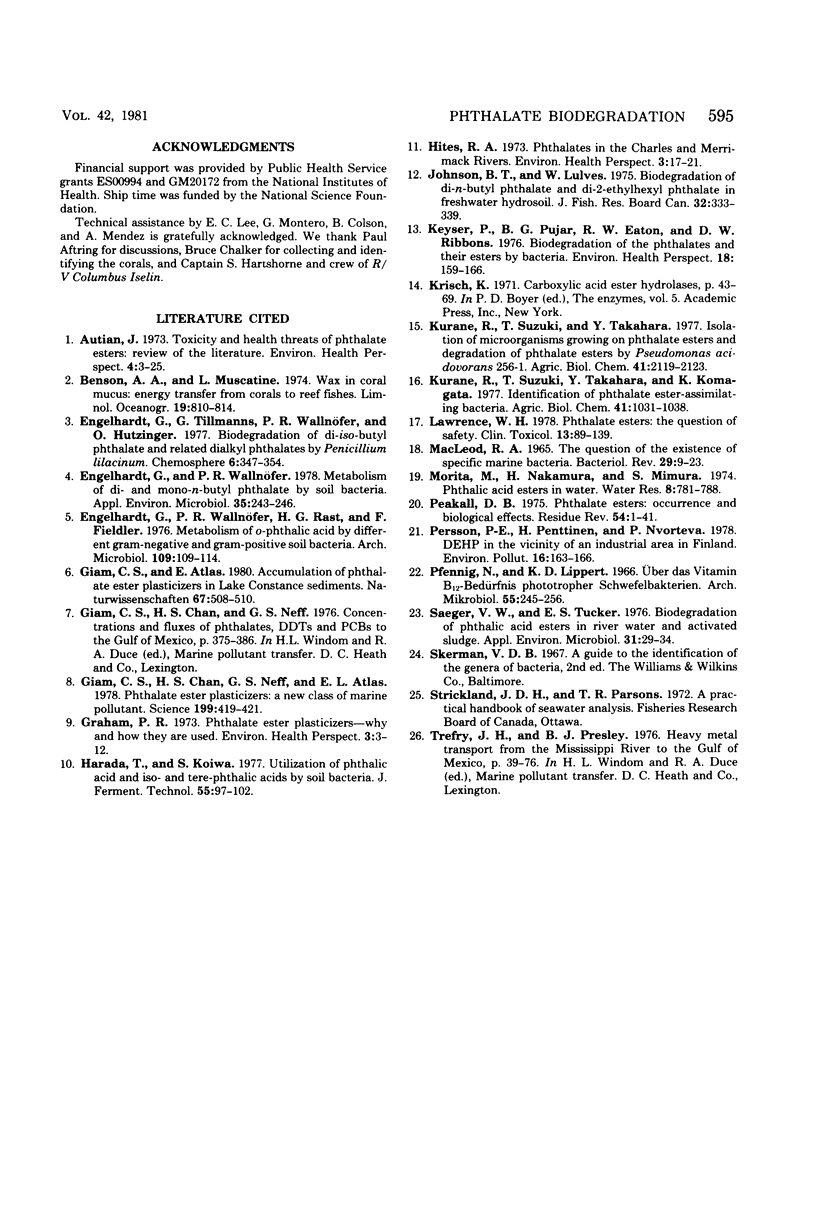Abstract
Di-(2-ethylhexyl) phthalate was the major phthalic acid ester in the Mississippi River estuary, with mean levels of 0.1 μg/g (dry weight) in surface sediments, 1.0 μg/liter in river water, and 0.7 μg/liter in delta water. Bacteria that grew aerobically on dibutyl phthalate and o-phthalic acid were readily detected in the sediments and water. Pure cultures of bacteria were isolated on seven different phthalic acid esters from freshwater and marine sources. The marine isolates were taxonomically diverse and grew on a variety of phthalic acid esters. Dibutyl phthalate and o-phthalic acid supported growth in full-strength synthetic sea-water medium, but Na+ -dependent catabolism was demonstrable only for o-phthalic acid.
Full text
PDF





Selected References
These references are in PubMed. This may not be the complete list of references from this article.
- Autian J. Toxicity and health threats of phthalate esters: review of the literature. Environ Health Perspect. 1973 Jun;4:3–26. doi: 10.1289/ehp.73043. [DOI] [PMC free article] [PubMed] [Google Scholar]
- Engelhardt G., Wallnöfer P. R. Metabolism of Di- and Mono-n-Butyl Phthalate by Soil Bacteria. Appl Environ Microbiol. 1978 Feb;35(2):243–246. doi: 10.1128/aem.35.2.243-246.1978. [DOI] [PMC free article] [PubMed] [Google Scholar]
- Giam C. S., Chan H. S., Neff G. S., Atlas E. L. Phthalate ester plasticizers: a new class of marine pollutant. Science. 1978 Jan 27;199(4327):419–421. [PubMed] [Google Scholar]
- Graham P. R. Phthalate ester plasticizers--why and how they are used. Environ Health Perspect. 1973 Jan;3:3–12. doi: 10.1289/ehp.73033. [DOI] [PMC free article] [PubMed] [Google Scholar]
- Hites R. A. Phthalates in the Charles and the Merrimack rivers. Environ Health Perspect. 1973 Jan;3:17–21. doi: 10.1289/ehp.730317. [DOI] [PMC free article] [PubMed] [Google Scholar]
- Keyser P., Pujar B. G., Eaton R. W., Ribbons D. W. Biodegradation of the phthalates and their esters by bacteria. Environ Health Perspect. 1976 Dec;18:159–166. doi: 10.1289/ehp.7618159. [DOI] [PMC free article] [PubMed] [Google Scholar]
- Lawrence W. H. Phthalate esters: the question of safety. Clin Toxicol. 1978;13(1):89–139. doi: 10.3109/15563657808988230. [DOI] [PubMed] [Google Scholar]
- MACLEOD R. A. THE QUESTION OF THE EXISTENCE OF SPECIFIC MARINE BACTERIA. Bacteriol Rev. 1965 Mar;29:9–24. [PMC free article] [PubMed] [Google Scholar]
- Peakall D. B. Phthalate esters: Occurrence and biological effects. Residue Rev. 1975;54:1–41. doi: 10.1007/978-1-4612-9857-1_1. [DOI] [PubMed] [Google Scholar]
- Saeger V. W., Tucker E. S. Biodegradation of phthalic acid esters in river water and activated sludge. Appl Environ Microbiol. 1976 Jan;31(1):29–34. doi: 10.1128/aem.31.1.29-34.1976. [DOI] [PMC free article] [PubMed] [Google Scholar]


